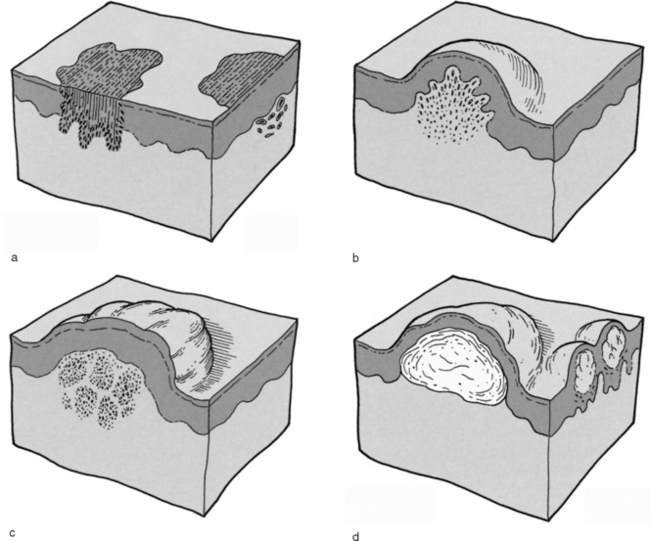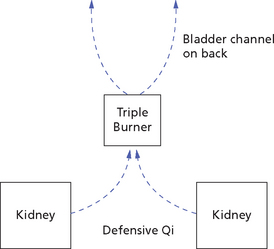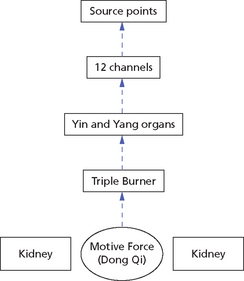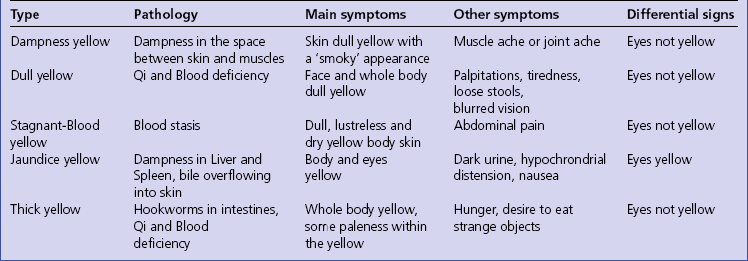Chapter 21 Fu indicates the superficial layer of skin (i.e. the epidermis), which is influenced mostly by the Lungs. Ge indicates the deep layer of skin (i.e. the dermis), which is influenced by the Lungs, Liver and Kidneys. Ji, a word that is sometimes translated as “flesh”, indicates the subcutaneous muscles and this structure is influenced by the Spleen and Liver. Fen Rou indicates two structures, i.e. fat (influenced by the Spleen, Kidneys and Directing Vessel) and muscles near the bones (influenced by the Spleen and Liver). Cou Li (therefore, the space between skin and muscles) is influenced by the Lungs and Spleen.1 Xuan Fu are the pores (including the sebaceous glands) through which the sweat comes out and they are influenced by the Lungs and Spleen. Box 21.1 summarizes the organs influencing each layer of the skin. Figure 21.1 shows the various types of skin lesions. Fig. 21.1 Skin lesions. a, Freckle; b, papule; c, dermatofibroma; d, vesicles; e, pustule; f, epidermal cyst; g, wheal; h, psoriasis plaque; i, white and silvery scale; j, ulcer (From Gawkrodger 1992, An Illustrated Colour Text of Dermatology, pp. 12–13, with permission of Churchill Livingstone.) Churchill Livingstone As a whole, the skin is influenced by the Lungs. Chapter 10 of the “Simple Questions” says: “The Lungs are connected to the skin and control the state of the body hair”.2 The Lungs also control the opening and closing of the pores and this function is related to the Lung’s diffusing of Defensive Qi to the skin. The pores were called “sweat holes” (Han Kong) and their function is to discharge turbid Qi and sweat. The Defensive Qi and, therefore, the Lung’s opening and closing of the pores, is a manifestation of the protective function of the Defensive Qi against the invasion of pathogenic factors. When the Defensive Qi is properly regulated, the pores are closed on exposure to a pathogenic factor and properly open during exercise or on exposure to hot weather. A weakness of Lung-Qi and of the Defensive Qi may lead to “flaccidity” of the pores and result in their being too open: this facilitates the invasion of pathogenic factors. In pathology, a weakness of Lung-Qi, and therefore of the Defensive Qi in the space between the skin and muscles, causes acute skin diseases due to invasion of external Wind such as urticaria. The Kidneys also influence the skin in other ways. First of all, although the Lungs diffuse Defensive Qi, and the Stomach and Spleen contribute to Defensive Qi’s production, the Defensive Qi stems from the Lower Burner and from the Kidneys. Defensive Qi is Yang in nature and it is therefore influenced by Kidney-Yang and the Fire of the Gate of Life. The Kidneys also play an important role in the distribution of Defensive Qi to all other channels and parts of the body with the aid of the Triple Burner and the Bladder channel. The Back Transporting points where the Defensive Qi infuses to the Internal Organs are situated in the back along the Bladder channel. This is because the Defensive Qi emerges from the Kidneys, through the Triple Burner, and flows up along the Bladder channel. Moreover, when the Defensive Qi emerges in the morning after flowing in the Yin organs at night, it starts from the Kidney channel (Chapter 76 of the “Spiritual Axis”)3 (Fig. 21.2). The Triple Burner also influences the skin and, in particular, the skin’s moisture, because it plays such an important role in the metabolism of fluids. One important aspect of the Triple Burner, in fact, is the diffusion of fluids in the Upper Burner, the separation and transformation of fluids in the Middle Burner and the excretion of fluids in the Lower Burner. As heat is needed to transform and excrete fluids, the Triple Burner relies on that derived from the Fire of the Gate of Life in between the Kidneys. From this point of view, the Triple Burner’s function of transporting and excreting fluids is inseparable from its location between the Kidneys where the Fire of the Gate of Life resides. For this reason, the Triple Burner is closely related to the Original Qi. Chapter 66 of the “Classic of Difficulties” states: The Motive Force (Dong Qi) that resides between the Kidneys below the umbilicus is the source of life (ming) and the root of the twelve channels and that is why it is called Original [Qi]. The Triple Burner is the emissary of the Original Qi.4 It penetrates through the three Burners and spreads to the five Yin and the six Yang organs. Original Qi is the honorary name for the Triple Burner and that is why the places where [the Qi of the Triple Burner] stops in turn are called Origin [Source] points. Therefore diseases of the five Yin and the six Yang organs can be reflected on the Origin [Source] points.5 As the Original Qi, which resides between the Kidneys, is the basis for the Triple Burner and transforms fluids that affect the skin, this is another way in which the Kidneys influence the skin (Fig. 21.3). Chapter 47 of the “Spiritual Axis” illustrates the connection between the skin and the Kidneys and Triple Burner: “The Kidneys are connected with the Triple Burner and the Bladder which influence the pores and body hair”.6 Another passage from Chapter 64 of the “Simple Questions” also illustrates the relationship between the Kidneys and the skin: “When there is a pathogenic factor in the Kidneys, the skin is affected and there is a rash.”7 Chapter 17 of the “Spiritual Axis” says: “The Main channels are in the Interior, their branches are horizontal [or crosswise] forming the Luo channels: branching out from these are the Minute Luo. When these are Full with stagnant Blood they should be drained with bleeding with needle; when they are deficient, they should be tonified with herbs”.8 Chapter 10 of the same book says: “The Main channels are deep and hidden between the muscles and cannot be seen; only the Spleen channel can be seen as it emerges from above the internal malleolus and it has no place to hide. The Luo channels are superficial and can be seen.”9 The same chapter also says: “When the Luo channels are greenish-bluish it indicates Cold and pain; when they are red it indicates Heat.”10 “Skin colour” refers to the colour of the body skin itself, as distinct from the complexion (discussed in Chapter 3). It does not refer to skin rashes, which will be discussed separately. The colours discussed are: Of course, when observing body-skin colour one should take into account individual variations due to race and occupation. This has already been discussed in Chapter 3 dealing with observation of the complexion. For example, a body skin that might be described as “pale” in a Mediterranean person would be normal in a Swedish person. Generally speaking, the colours described below apply to any racial group: for example, the body skin of an African-American or an Indian may be pale in colour, like a Caucasian’s, although it will obviously look different. Apart from the colour, other aspects of the skin should be considered: Lustre in relation to the skin has already been described in the chapter on Complexion (Chapter 3). A body skin with lustre indicates a good state of Body Fluids and of the Lungs, Stomach and Liver. The space between the skin and muscles, called Cou Li, is where the Defensive Qi flows and where sweat comes from.11 The state of the space can be deduced by observing the state of the pores, sweat and skin texture. One should differentiate between a state of openness or closure and one of looseness or tightness. Yin macules start gradually and are not associated with an external origin or a febrile disease: they are generally due either to chronic Blood-Heat or to Qi deficiency. As for the colour, one should differentiate the following colours of macules: Purple macules indicate Blood-Heat with Blood stasis. (See Plates 21.1 and 21.2 on p. P9.) A wheal, called Feng Tuan in Chinese, is a type of papule (although it may also be a plaque) characterized by a transitory, compressible elevation of skin with dermal oedema, red or white in colour. Urticaria is a typical example of skin eruptions with wheals. Pale wheals are caused by invasion of Wind-Cold or Yang deficiency; red wheals are caused by Heat or Empty-Heat; dark, purple wheals indicate Blood stasis. (See Plate 21.3 on p. P9). A plaque, in Chinese called Ban, is a type of papule: it is a palpable, plateau-like elevation of skin, usu-ally more than 2 cm in diameter. Certain psoriasis lesions are typical examples of plaques. The clinical significance of plaques is the same as that of papules, that is, red plaques signify Heat while dark ones indicate Heat with Blood stasis. The fact that the Chinese name for plaques is the same as that for macule (Ban) should not induce us to infer that plaques indicate Blood-Heat (as do macules). (See Plate 21.4 on p. P9.)
 OBSERVATION OF THE SKIN
OBSERVATION OF THE SKIN
INTRODUCTION
Skin layers
Types of skin lesion


THE SKIN AND THE INTERNAL ORGANS
The skin and the Lungs
The skin and the Kidneys
The skin and the Connecting channels
SKIN SIGNS
Skin colour
Skin texture
Lustre
The space between skin and muscles (Cou Li)
Macules, papules, vesicles and pustules
Macules
Purple macules
Papules
![]()
Stay updated, free articles. Join our Telegram channel

Full access? Get Clinical Tree


OBSERVATION OF THE SKIN



